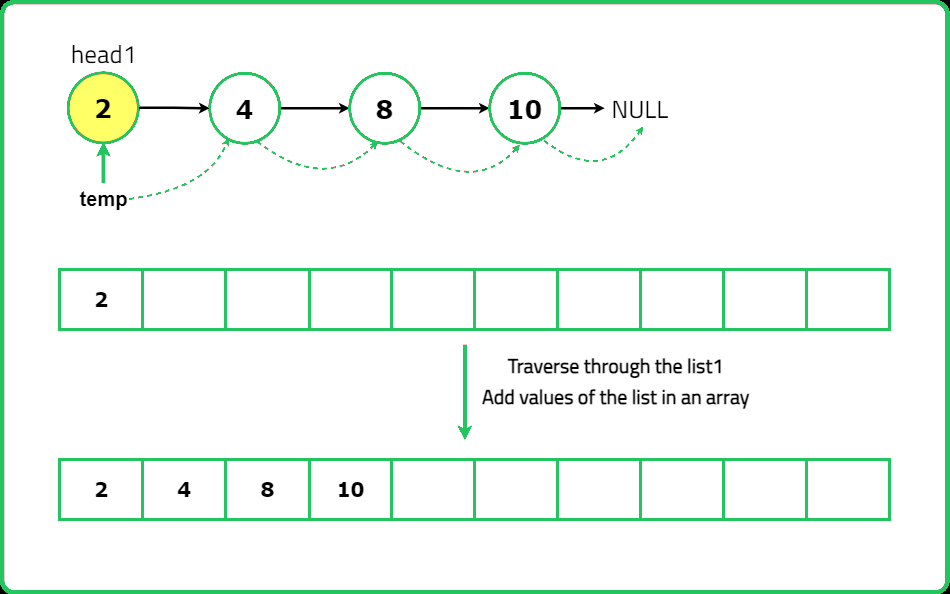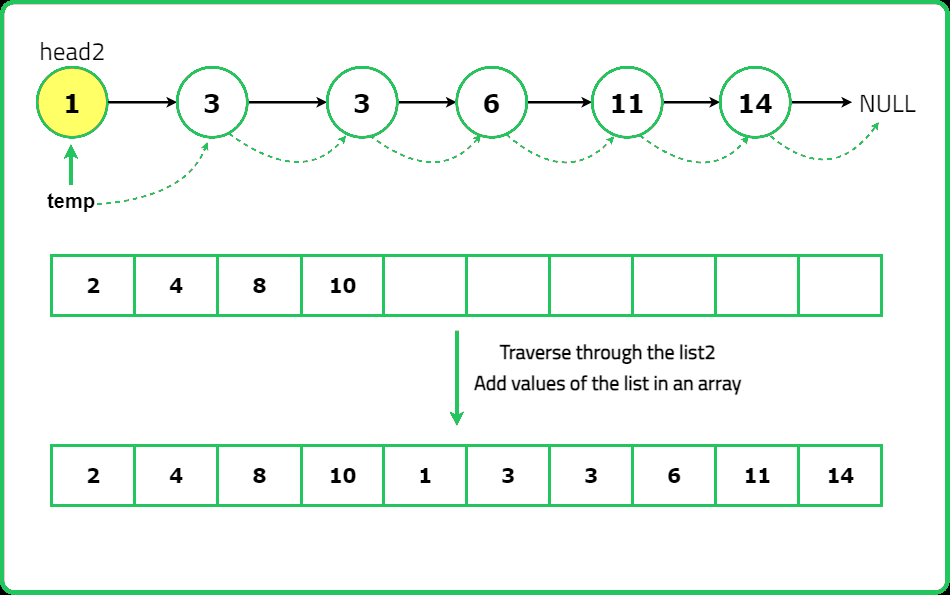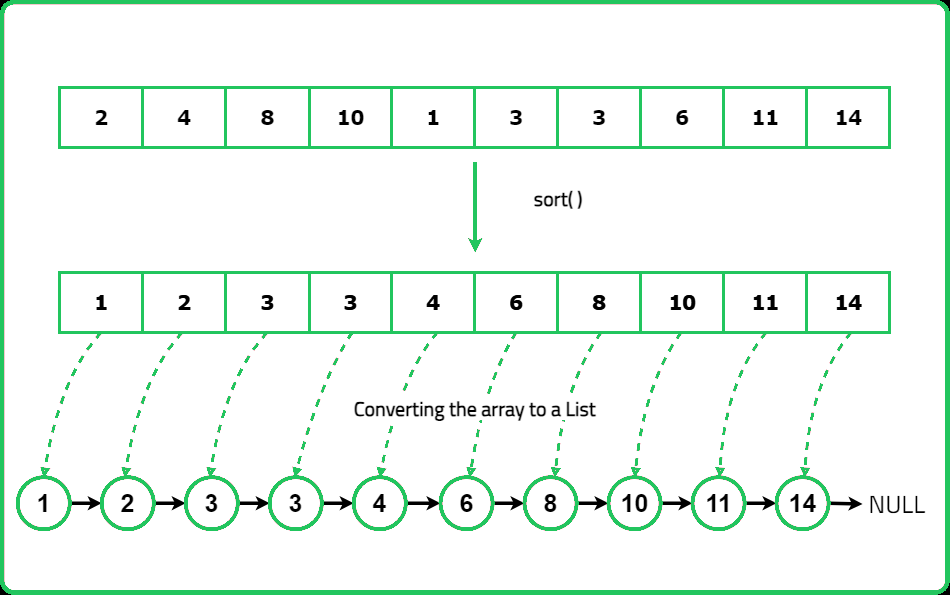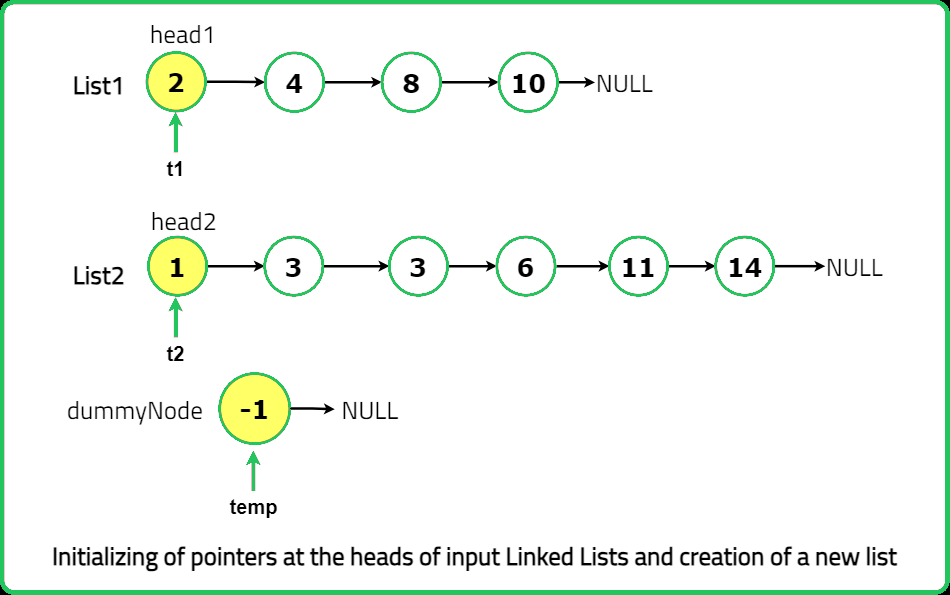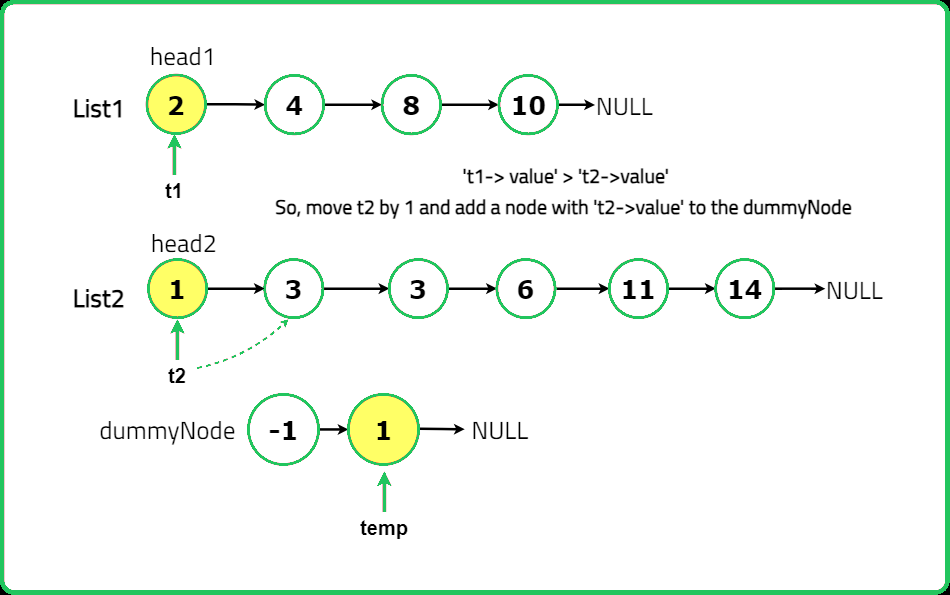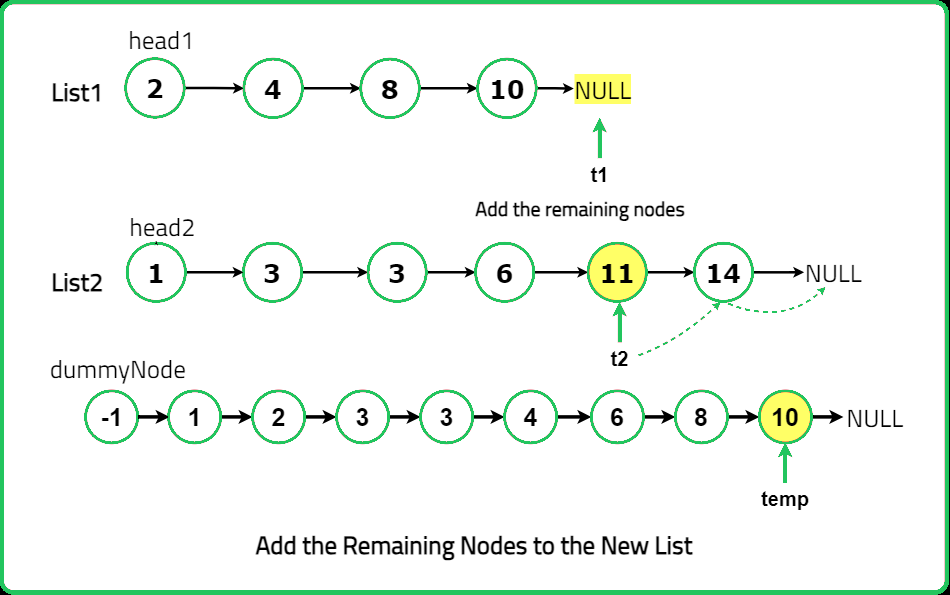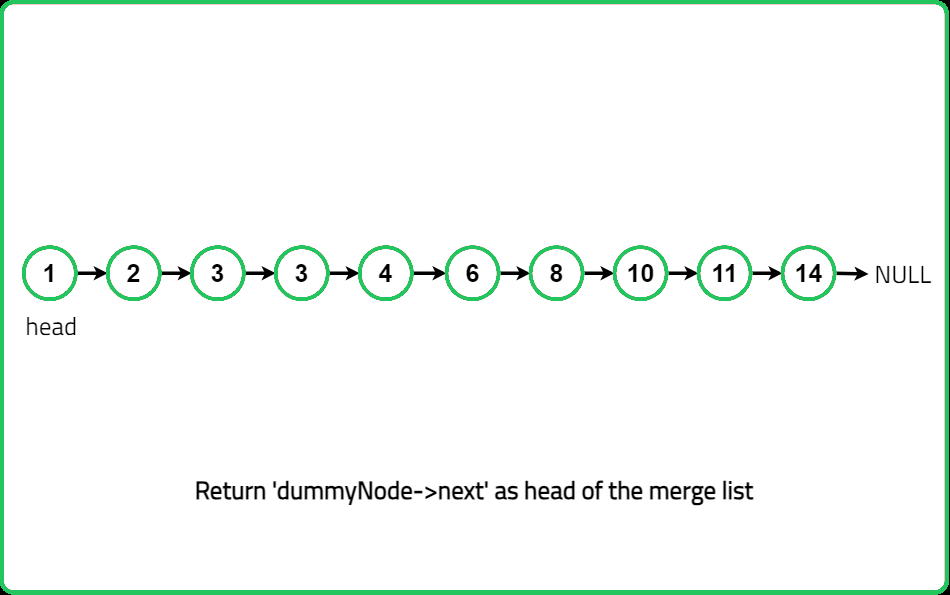1234567891011121314151617181920212223242526272829303132333435363738394041424344454647484950515253545556575859606162636465666768697071727374757677787980818283848586878889909192939495
#include <bits/stdc++.h>
using namespace std;
// Definition of singly linked list
struct ListNode {
int val;
ListNode *next;
ListNode(int data1) {
val = data1;
next = NULL;
}
ListNode(int data1, ListNode *next1) {
val = data1;
next = next1;
}
};
class Solution {
public:
// Function to merge two sorted linked lists
ListNode* mergeTwoLists(ListNode* list1, ListNode* list2) {
// Create a dummy node to serve as
// the head of the merged list
ListNode* dummyNode = new ListNode(-1);
ListNode* temp = dummyNode;
// Traverse both lists simultaneously
while (list1 != nullptr && list2 != nullptr) {
/*Compare elements of both lists
and link the smaller node
to the merged list*/
if (list1->val <= list2->val) {
temp->next = list1;
list1 = list1->next;
} else {
temp->next = list2;
list2 = list2->next;
}
// Move the temporary pointer
// to the next node
temp = temp->next;
}
/*If any list still
has remaining elements,
append them to the merged list*/
if (list1 != nullptr) {
temp->next = list1;
} else {
temp->next = list2;
}
// Return merged list
return dummyNode->next;
}
};
// Function to print the linked list
void printLinkedList(ListNode* head) {
ListNode* temp = head;
while (temp != nullptr) {
// Print the data of the current node
cout << temp->val << " ";
// Move to the next node
temp = temp->next;
}
cout << endl;
}
int main() {
// Example Linked Lists
ListNode* list1 = new ListNode(1);
list1->next = new ListNode(3);
list1->next->next = new ListNode(5);
ListNode* list2 = new ListNode(2);
list2->next = new ListNode(4);
list2->next->next = new ListNode(6);
cout << "First sorted linked list: ";
printLinkedList(list1);
cout << "Second sorted linked list: ";
printLinkedList(list2);
Solution solution;
ListNode* mergedList = solution.mergeTwoLists(list1, list2);
cout << "Merged sorted linked list: ";
printLinkedList(mergedList);
return 0;
}
123456789101112131415161718192021222324252627282930313233343536373839404142434445464748495051525354555657585960616263646566676869707172737475767778798081828384858687888990
import java.util.*;
// Definition of singly linked list
class ListNode {
int val;
ListNode next;
ListNode(int data1) {
val = data1;
next = null;
}
ListNode(int data1, ListNode next1) {
val = data1;
next = next1;
}
}
class Solution {
// Function to merge two sorted linked lists
public ListNode mergeTwoLists(ListNode list1, ListNode list2) {
// Create a dummy node to serve as
// the head of the merged list
ListNode dummyNode = new ListNode(-1);
ListNode temp = dummyNode;
// Traverse both lists simultaneously
while (list1 != null && list2 != null) {
/*Compare elements of both lists
and link the smaller node
to the merged list*/
if (list1.val <= list2.val) {
temp.next = list1;
list1 = list1.next;
} else {
temp.next = list2;
list2 = list2.next;
}
// Move the temporary pointer
// to the next node
temp = temp.next;
}
/*If any list still
has remaining elements,
append them to the merged list*/
if (list1 != null) {
temp.next = list1;
} else {
temp.next = list2;
}
// Return merged list
return dummyNode.next;
}
}
// Function to print the linked list
public static void printLinkedList(ListNode head) {
ListNode temp = head;
while (temp != null) {
// Print the data of the current node
System.out.print(temp.val + " ");
// Move to the next node
temp = temp.next;
}
System.out.println();
}
public static void main(String[] args) {
// Example Linked Lists
ListNode list1 = new ListNode(1);
list1.next = new ListNode(3);
list1.next.next = new ListNode(5);
ListNode list2 = new ListNode(2);
list2.next = new ListNode(4);
list2.next.next = new ListNode(6);
System.out.print("First sorted linked list: ");
printLinkedList(list1);
System.out.print("Second sorted linked list: ");
printLinkedList(list2);
Solution solution = new Solution();
ListNode mergedList = solution.mergeTwoLists(list1, list2);
System.out.print("Merged sorted linked list: ");
printLinkedList(mergedList);
}
123456789101112131415161718192021222324252627282930313233343536373839404142434445464748495051525354555657585960616263646566676869707172
# Definition of singly linked list
class ListNode:
def __init__(self, val=0, next=None):
self.val = val
self.next = next
class Solution:
# Function to merge two sorted linked lists
def mergeTwoLists(self, list1: ListNode, list2: ListNode) -> ListNode:
# Create a dummy node to serve as
# the head of the merged list
dummyNode = ListNode(-1)
temp = dummyNode
# Traverse both lists simultaneously
while list1 is not None and list2 is not None:
'''Compare elements of both lists
and link the smaller node
to the merged list'''
if list1.val <= list2.val:
temp.next = list1
list1 = list1.next
else:
temp.next = list2
list2 = list2.next
# Move the temporary pointer
# to the next node
temp = temp.next
'''If any list still
has remaining elements,
append them to the merged list'''
if list1 is not None:
temp.next = list1
else:
temp.next = list2
# Return merged list
return dummyNode.next
# Function to print the linked list
def printLinkedList(head: ListNode):
temp = head
while temp is not None:
# Print the data of the current node
print(temp.val, end=" ")
# Move to the next node
temp = temp.next
print()
if __name__ == "__main__":
# Example Linked Lists
list1 = ListNode(1)
list1.next = ListNode(3)
list1.next.next = ListNode(5)
list2 = ListNode(2)
list2.next = ListNode(4)
list2.next.next = ListNode(6)
print("First sorted linked list: ", end="")
printLinkedList(list1)
print("Second sorted linked list: ", end="")
printLinkedList(list2)
solution = Solution()
mergedList = solution.mergeTwoLists(list1, list2)
print("Merged sorted linked list: ", end="")
printLinkedList(mergedList)
1234567891011121314151617181920212223242526272829303132333435363738394041424344454647484950515253545556575859606162636465666768697071727374757677787980
// Definition of singly linked list
class ListNode {
constructor(val = 0, next = null) {
this.val = val;
this.next = next;
}
}
class Solution {
// Function to merge two sorted linked lists
mergeTwoLists(list1, list2) {
// Create a dummy node to serve as
// the head of the merged list
let dummyNode = new ListNode(-1);
let temp = dummyNode;
// Traverse both lists simultaneously
while (list1 !== null && list2 !== null) {
/*Compare elements of both lists
and link the smaller node
to the merged list*/
if (list1.val <= list2.val) {
temp.next = list1;
list1 = list1.next;
} else {
temp.next = list2;
list2 = list2.next;
}
// Move the temporary pointer
// to the next node
temp = temp.next;
}
/*If any list still
has remaining elements,
append them to the merged list*/
if (list1 !== null) {
temp.next = list1;
} else {
temp.next = list2;
}
// Return merged list
return dummyNode.next;
}
}
// Function to print the linked list
function printLinkedList(head) {
let temp = head;
while (temp !== null) {
// Print the data of the current node
process.stdout.write(temp.val + " ");
// Move to the next node
temp = temp.next;
}
console.log();
}
// Example Linked Lists
let list1 = new ListNode(1);
list1.next = new ListNode(3);
list1.next.next = new ListNode(5);
let list2 = new ListNode(2);
list2.next = new ListNode(4);
list2.next.next = new ListNode(6);
console.log("First sorted linked list: ");
printLinkedList(list1);
console.log("Second sorted linked list: ");
printLinkedList(list2);
let solution = new Solution();
let mergedList = solution.mergeTwoLists(list1, list2);
console.log("Merged sorted linked list: ");
printLinkedList(mergedList);
